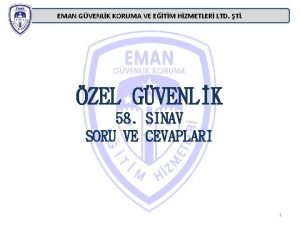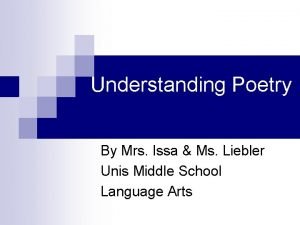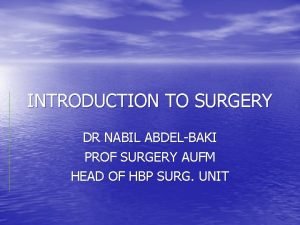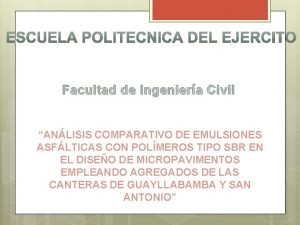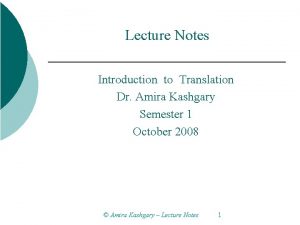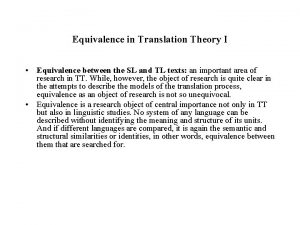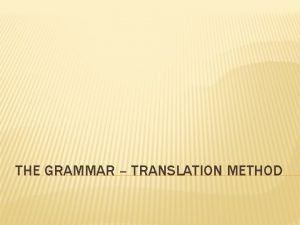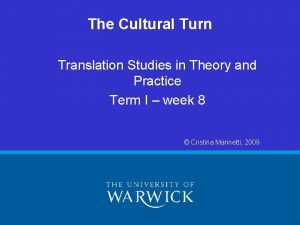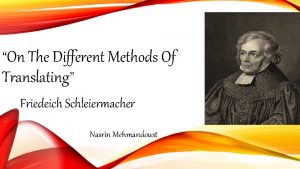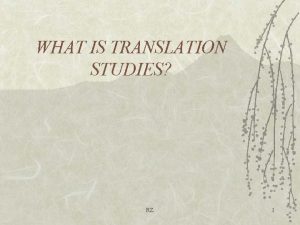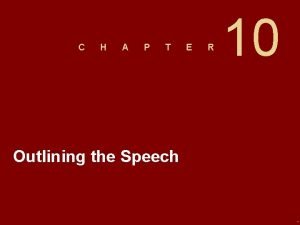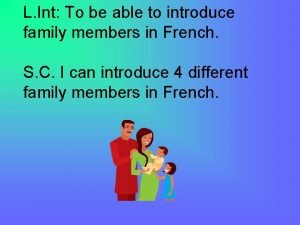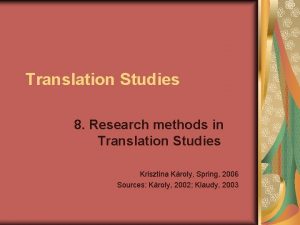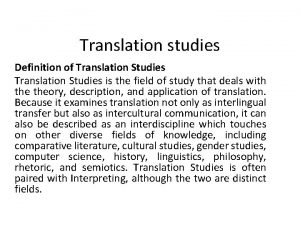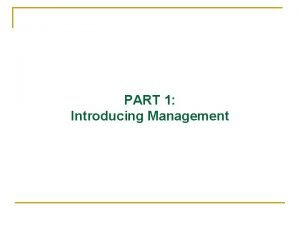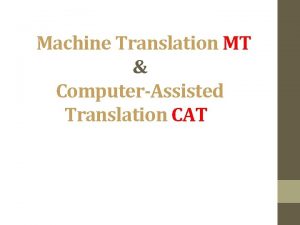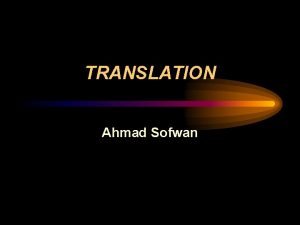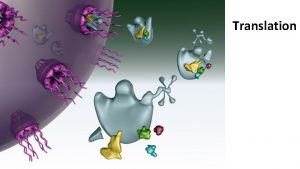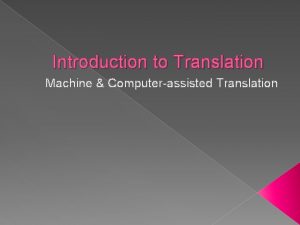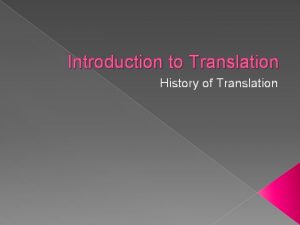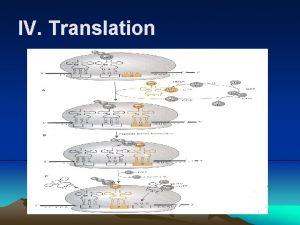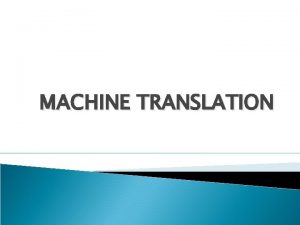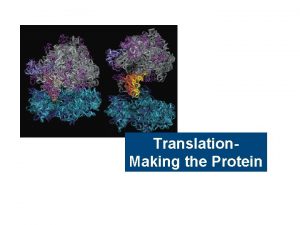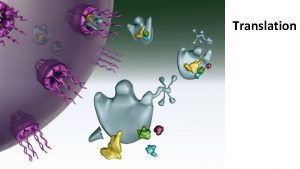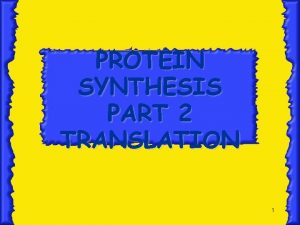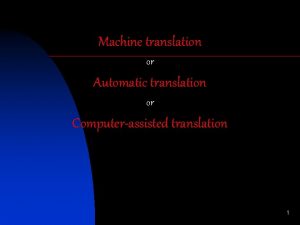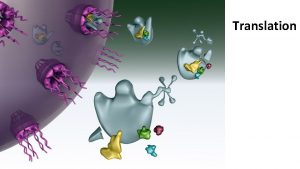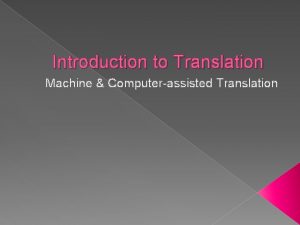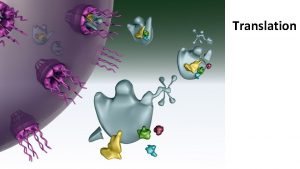Introducing translation studies Eman Issa Outline Translation main






































- Slides: 38


Introducing translation studies Eman Issa

Outline �Translation main taxonomies �Vinay and Darbelnet approach �Differences between strategies and procedures �Levels of translation �Translation strategies �Some analytical steps

Translation main taxonomies 1) Vinay and Darbelnet’s taxonomy in Comparative Stylistics of French and English (1958/1995). 2) Catford’s (1965) linguistic approach.

Vinay and Darbelnet’s approach • Their approach Influenced by earlier work by the Russian theorist and translator Andrei Fedorov (1953), as described by Mossop (2013) and Pym (2016), Vinay and Darbelnet carried out a comparative stylistic analysis of French and English. They looked at texts in both languages, noting differences between the languages and identifying different translation ‘strategies’ and ‘procedures’.

Strategy vs. Procedure Strategy Procedure • is an overall orientation of the translator (e. g. towards ‘free’ or ‘literal’ translation, towards the TT or ST, towards domestication or foreignization). • specific technique or method used by the translator at a certain point in a text (e. g. the borrowing of a word from the SL, the addition of an explanation or a footnote in the TT).

�Although their model is based on comparative analysis between English and French, it has a great influence on the field of translation. it also motivates works on French–German translation (Malblanc 1944/1963) and inspired two similar books on English–Spanish translation: 1. Introduction to traductology (1977) written by Vázquez-Ayora. 2. Theory and practice of translation (1982) written by García Yebra.

Levels of translation Lexicon Structure Syntactic Message Metalinguistics Units of thought Phrases and chunks Microlinguistics Units of translation (vocabulary) Tone, link, style, emphasis (context) Morphology and Sentence and syntax (grammar) paragraph

Two strategies and seven procedures �Two general translation strategies identified by Vinay and Darbelnet (1995/2004: 128– 37) are i. direct translation and ii. oblique translation �The two strategies comprise seven procedures, of which direct translation covers the first three procedures.

�Borrowing refers to a case where a word or an expression is taken from SL and used in the TL, but in a "naturalized" form, it is made to conform to the rules of grammar or pronunciation of the TL.

Reasons for language borrowings: �One language may possess words for which there are no equivalents in the other language. There may be no words for objects, social, political, and cultural institutions and events or abstract concepts which are not found in the culture of the other language.

Calque �A phrase borrowed from another language and translated literally word-for-word. - Calque may introduce a structure that is stranger from the TL. - Calque expressions consist of imitating the manner of expression of the ST and TT.


�Vinay and Darbelnet note that both borrowings and calques often become fully integrated into the TL, although sometimes with some semantic change, which can turn them into false friends

Literal translation �This is ‘word-for-word’ translation Which can only be used between languages of the same families and cultures such as Indo-European languages. �Literal translation is a far-fetched between languages of different families as Arabic and English.

�It can be sometimes applicable as in the English. Arabic pairs as in: �I get up early everyday � ﺃﺴﺘﻴﻘﻆ ﻣﺒﻜﺮ ﻛﻞ ﻳﻮﻡ � ﻭﺻﻠﺖ ﺇﻟﻰ ﺍﻟﻤﻄﺎﺭ ﻓﻲ ﺍﻟﻠﻴﻞ �I arrived to the airport at night.

�However, Munday contends that literal translation is the author’s prescription for good translation unless the technique becomes unacceptable because it: ⁃ gives a different meaning ⁃ has no meaning ⁃ is impossible for structural reasons ⁃ does not have a corresponding expression within the metalinguistic experience of the target language.

- Correspond to something at a different level of language. �These restrictions cannot lead to a good translation as there is certain degrees of adherence to the target language. �The translator will face at some point some cases where the literal translation is not enough and the transposition or adaptation have to be applied.

Oblique translation �Oblique or indirect translation involves the following four sub-classes. 1. Transposition 2. Modulation 3. Equivalence 4. Adaptation

Transposition � Transposition involves the replacement of one word class with another (e. g. noun for verb) without changing the sense/meaning. �Transposition can be either obligatory (servitude) or optional. Notice the following examples;


Modulation �Modulation entails a change of the message due to change of the point of view. �A negative ST expression could be changed into positive through modulation as in “ it is not a strong argument” and the juxtaposed translation ﺣﺠﺔ ﻭﺍﻫﻴﺔ. As we have seen in transposition, using modulation can also be an obligation or only an option.

Example: �The English sentence “the economy did not stop growing” can be translated as: Literal translation . ﻟﻢ ﻳﺘﻮﻗﻒ ﺍﻻﻗﺘﺼﺎﺩ ﻋﻦ ﺍﻟﻨﻤﻮ. 1 Modulation . ﻳﻨﻤﻮ ﺍﻻﻗﺘﺼﺎﺩ ﻧﻤﻮ ﺛﺎﺑﺘ. 2

�According to Venuti, the translator is obliged to use this method when the literal or transposed translation is considered as unsuitable or unidiomatic in the TL. Translate using Modulation ? � Where is Ali? No one knows. � A equals the half of B. � ﺣﺠﺔ ﺑﺎﺭﺩﺓ � ﺷﺎﻱ ﺛﻘﻴﻞ

�Vinay and Darbelnet describe modulation as ‘the touchstone of a good translator’, whereas transposition ‘simply shows a very good command of the target language’.

Equivalence �Equivalence refers to “a strategy to describe the same situation by using completely different stylistic or structural methods for producing equivalent text. �Equivalence is particularly useful for the translation of proverbs and idioms as they include both the connotative and denotative meanings.

Arabic Idiom English Literal Meaning English equivalent meaning ﺿﻊ ﻳﺪﻙ ﺑﻤﺎﺀ ﺑﺎﺭﺩ Put your hand in cold water Don’t worry/be certain ﻇﻫﺮﻩ ﻣﺴﻨﻮﺩ His back is supported He is backed up/ he’s got connections ﻣﻘﻄﻮﻉ ﻣﻦ ﺷﺠﺮﺓ Cut off from a tree He’s got no family / relatives If the judge is satisfied Keep way please. Not want to interfere He ate the green and the dry To wipe out/destroy completely Patience is the key to relief Be patient ﺍﺫﺍ ﺍﻟﻘﺎﺿﻲ ﺭﺍﺿﻲ ﺍﻷﺨﻀﺮ ﻭﺍﻟﻴﺎﺑﺲ ﺃﻜﻞ ﺍﻟﺼﺒﺮ ﻣﻔﺘﺎﺡ ﺍﻟﻔﺮﺝ

Translate the following: ⁃ ⁃ A sitting duck Fool’s paradise Of the deepest dye Hit upon (something)

Adaptation �This involves changing the cultural reference when a situation in the source culture does not exist in the target culture as in the case of translating the names of films and novels. �The procedure of adaptation corresponds to the free translation method where both the words and the sense of the source text are for saken in the target language product.

�Adaptation can be placed on a continuum between extreme departure from the source text and minor deviation from its semantics. § Kane and Abel, a novel written by Jeffrey Archer, was titled in Arabic ﺍﻷﻌﺪﺍﺀ ﺍﻷﺨﻮﺓ § The translator of the novel completely ignored the words of the source title and chose a new title that maintains the functions of allusion and opposition in the target language. Similarly, adapting the title into ﻟﻌﺒﺔ ﺍﻟﻘﺪﺭ would be an equally appropriate choice instead of rendering the title formally into its corresponding allusion in Arabic, i. e. ﻗﺎﺑﻴﻞ ﻭﻫﺎﺑﻴﻞ

§ Danielle Steel's Matters of the heart appears in its Arabic edition as ﻫﻤﻮﻡ ﺍﻟﻘﻠﺐ § the masterpiece novel and later produced movie Slumdog millionaire is translated as ﺍﻟﻤﻠﻴﻮﻧﻴﺮ ﺍﻟﻤﺘﺸﺮﺩ § Appointment with Death, a detective novel by Agatha Christie, is translated into ﺍﻟﻤﻮﻋﺪ ﺍﻟﺪﺍﻣﻲ

Suggested techniques Amplification; The TL uses more words, often because of syntactic expansion, False friend; A structurally similar term in SL and TL which deceives the user into thinking the meaning is the same ( ﻣﻜﺘﺒﺔ ) is either a book store or a library.

�Loss, gain and compensation; Translation does inevitably involve some loss, since it is impossible to preserve all the ST nuances of meaning and structure in the TL. However, importantly a TT may make up for (‘compensate’) this by introducing a gain at the same or another point in the text

� Explicitation; Implicit information in the ST is rendered explicit in the TT. This may occur on different levels; grammatical( doctor), semantic (cultural differences) , pragmatic (opaque idioms) and discourse( increasing cohesion) levels. Generalization; The use of a more general word in the TT.

Vinay and Darbelnet (ibid. : 30– 1) list five analytical steps for the translator to follow in moving from ST to TT. These are as follows: 1. Identify the units of translation. 2. Examine the SL text, evaluating the descriptive, affective and intellectual content of the units. 3. Reconstruct the metalinguistic context of the message. 4. Evaluate the stylistic effects. 5. Produce and revise the TT

�The authors reject the individual word. They consider the unit of translation to be a combination of a ‘lexicological unit’ and a ‘unit of thought’ and define it (ibid. : 21) as ‘the smallest segment of the utterance whose signs are linked in such a way that they should not be translated individually. �To facilitate analysis where oblique translation is used, Vinay and Darbelnet suggest numbering the translation units in both the ST and TT.

�The units which have the same number in each text can then be compared to see which translation procedure has been adopted. �The approach was criticised as to be difficult to adopt or to use. What do you think? ? ?

 Eman nayyab
Eman nayyab Eman güvenlik
Eman güvenlik What is a nonsense poem
What is a nonsense poem Anwar issa
Anwar issa 6 steps of risk management framework
6 steps of risk management framework Dr nabil issa
Dr nabil issa Issa raleigh
Issa raleigh Ghassan issa
Ghassan issa Issa associates degree
Issa associates degree Issa saleh
Issa saleh Issa tb 109
Issa tb 109 Falibi
Falibi Issalink
Issalink Richy carrasco
Richy carrasco Issa ottawa
Issa ottawa Estimating earthwork volumes
Estimating earthwork volumes Issa san francisco
Issa san francisco Paradigm shift from women studies to gender studies
Paradigm shift from women studies to gender studies Social studies essay format
Social studies essay format Sandwich in a sentence
Sandwich in a sentence Translation studies lecture notes
Translation studies lecture notes Theory of equivalence in translation
Theory of equivalence in translation Equivalence and equivalent effect
Equivalence and equivalent effect Advantages and disadvantages of gtm
Advantages and disadvantages of gtm Cultural turn translation studies
Cultural turn translation studies Domestication in translation studies
Domestication in translation studies Holmes translation studies
Holmes translation studies Ac 120-16
Ac 120-16 Outline main idea and supporting details
Outline main idea and supporting details Concept map main idea supporting details
Concept map main idea supporting details The visual framework of a preparation outline
The visual framework of a preparation outline Signal phrase adalah
Signal phrase adalah A concise introduction to linguistics
A concise introduction to linguistics 1941-1882
1941-1882 Body paragraph starters
Body paragraph starters Counterclaims in argumentative writing
Counterclaims in argumentative writing Unit 1 about myself
Unit 1 about myself How to introduce yourself in training session
How to introduce yourself in training session Introducing family members in french
Introducing family members in french

